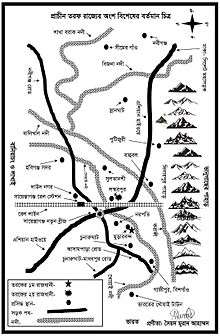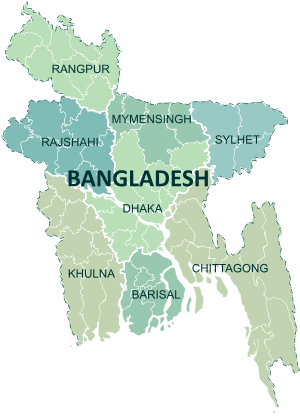Habiganj District
| Habiganj | |
|---|---|
 | |
| Division | Sylhet Division |
| Area | |
| • Total | 2,636.59 km2 (1,017.99 sq mi) |
| Population (2011 census) | |
| • Total | 2,089,001 |
| • Density | 790/km2 (2,100/sq mi) |
| Time zone | BST (UTC+6) |
| Postal code | 3360-3374 |

Habiganj (হবিগঞ্জ Hobigônj), formerly Habibganj, which was named after its founder, Syed Habib Ullah of Taraf fiefdom, is a district in the north-eastern part of Bangladesh. Between and thirteenth and early seventeenth centuries, Habiganj was part of the state of Nasirabad, which was established by Sipahisalar Syed Nasiruddin with its capital at Murarband Darbar Sharif,[1] Taraf. At present, it is a district of Sylhet Division.[2][3]
With the passage of time, Habibganj turned into Habiganj. During the British Raj, Habiganj was established as a Thana (police precinct) in 1790, under Dhaka district (1779–1793). Until 1896, Habiganj's administrative centre was in Court Andar, Laskarpur. On 12 September 1874 it came under Sylhet district (part of Assam). Habiganj was declared as subdivision in 1867. On 7 April 1893, according to Notification #273 of Assam Provincial Government, Habiganj Thana (Administrative unit) was established. Habiganj was rejoined with East-Bengal (now Bangladesh) in 1911. Then the Office of the Circle Officer (Development) was established in 1960. On 1 March 1984 Habiganj was established as a District.Sheikh Liaquat Ali is the current chairman of Habiganj.[4]
At present Habiganj consists of 8 upazilas, 6 municipalities, 36 wards, 77 union parishads, 124 mahallas, 1241 mouzas and 2076 villages.[5]
History
Chaklapunji
All the reported prehistoric records of Bangladesh are associated with the Lalmai hills and the higher areas of Sylhet, Habiganj, and Chittagong and Madhupur tract. The prehistoric site of Chaklapunji tea garden, near Chandirmazar of Chunarughat. Habiganj has also revealed a significant number of prehistoric tools from the bed of a small ephemeral stream (water remains here only for a few hours after rainfall) known as Balu nadi (river). Angularity and freshness of the fossil wood artifacts suggest that they did not come from a great distance and probably came from nearby hillocks. Typologically, technologically, and morphometrically, the artifacts are more or less the same as those found in the Lalmai area. The Fossil wood assemblages of Lalmai and Chaklapunji can be classified into two groups:
- Pre-neolithic assemblages without polished tools (hand axes, cleavers, scrapers, chopping tools, points etc.);
- Neolithic assemblages (hand adzes, polished Celts, awls etc.).
Battle of Bara Bhuiyans and Mughal
In Baniachang a battle occurred between Anwar Khan (the Zamindar of Sylhet) and Hussain Khan (Baro-Bhuyans of Baniachang) with the Mughal army in the 17th century, which can be found in the Bahrastan-i-Gayebi.
Fort of Putijuri
Khwaja Osman (Afghan king) left Bukai Nagar Fort and established a shelter at Putijuri on the foot of the Giripal. He also established a fort at Putijuri, which was extremely important for defense. The Mughal army took the advantage when Khwaja Osman's brother was absent from the fort, and finally defeated the Khwaja Osman's army at the village called Dhalamvapur, Maulvi Bazar District.
Indian National Congress
In the second session of the Congress held in Calcutta in 1886, the Indian National Congress was able to attract representatives from Habiganj District.
Liberation War of 1971
Habiganj is the historical place where the Mukti Bahini started their first guerrilla movement against oppression of Pakistani Army.
War at Teliapara Tea Garden
On 4 April 1971, during Bangladesh Liberation War the senior army officers assembled at the headquarters of 2nd East Bengal at Teliapara, a semi hilly area covered by tea gardens where General MAG Osmani, Lieutenant Colonel Abdur Rob, Lieutenant Colonel Salahuddin Mohammad Reja, Major Kazi Nuruzzaman, Major Khaled Mosharraf, Major Nurul Islam, Major Shafat Jamil, Major Mainul Hossain Chowdhury, and others were present.
At this meeting four senior commanders were entrusted with the responsibility of operational areas. Sylhet-Brahmanbaria area was placed under the command of Major Shafiullah, Comilla-Noakhali area was given to Major Khaled Mosharraf while Chittagong-Chittagong Hill Tracts was given to Major Ziaur Rahman and Kushtia-Jessore area was placed under command of Major Abu Osman Chowdhury. In the meeting the organization concept of the freedom fighter forces and the command structure were chalked out under the command of General MAG Osmani.[6]
War at Ajmiriganj
During the War of Liberation in 1971 an 18 hours direct encounter between the freedom-fighters and the Pakistani-army was held on 16 November 1971, in which freedom-fighter Jagatyoti and 11 villagers were killed by the Pakistani-army.[7]
Demography
As per district administration report[4] the total population is 1,830,554 of 926,531 male and 904,022 female (50.6% male and 49.4% female). Category by religion 80.23% Muslim, 19.12% Hindu, 0.05% Buddhist, 0.13% Christian and 0.47% others. Life Expectancy: 56 years both male and female. Age Breakdown: 42% (under 15); 26% (15-29); 16% (30-44); 9% (45-59); 5% (60 and 60+); and 2% (not known). Birth Rate: 33.0 per 1,000. Death Rate: 11.4 per 1,000. Population growth rate: 21.6 per 1,000. Infant Mortality Rate: 98.0 per 1,000 live births.
Over 98% of the population are Bengalis while the remainder are Biharis, Khasia, Manipuri and Tripuri people.
The Twipra or Tipperah are the original inhabitants of the state of Tripura. The Royal family of the Debbarma ruled the state of Tripura for more than 2,000 years till the kingdom was joined with the India in 1949.
The Manipuris' original homeland is Manipur, once a sovereign state and now the north-eastern state of India. In the early days, Manipur had different names such as Kangleipak, Kangkleipang, Kanglei, Meitrabak, and Mekhali and the Manipuri were known as Meitei. During the reign of Maharaj Garibniwaz (1709–1748), Manipuris arrived here. The Khasia is a Mongolite ethnic group. The Khasi descended to the Khasia hills and Jaintia hills from Cherrapunji and Shilong regions. They migrated to Habiganj from Assam where they arrived some 500 years ago.
Upazila

Habiganj District comprises nine Upazilas (sub-districts);
- Ajmiriganj
- Baniachang
- Bahubal
- Chunarughat
- Habiganj Sadar
- Lakhai
- Madhabpur
- Nabiganj
- Shaistagonj
Geography
Habiganj is located at 24°22′30″N 91°25′00″E / 24.3750°N 91.4167°E. Its area is 2,636.58 km² and bounded by Sunamganj District to the north, Tripura of India and Maulvibazar District to the east, Balaganj Upazila of Sylhet to the north-east, Brahmanbaria and Kishoreganj districts to the west.[5]
This part of Bangladesh is characterized by alluvial plains which are dissected by various connecting rivers as well as streams, lakes; and it is vulnerable to both flood and drought. The land is devoted mainly to agriculture due to its fertile alluvial soils.
Land
Cultivated agricultural land: 1,54,953 hectare (60.22% of the total agricultural land). Forestland 95 11,644 hectare (4.53% of the total land). For crops 51.6% single-crop, 38.7% double-crop and 9.7% triple-crop; fallow 521 hectares. Its rivers include Barak, Bheramahana, Gopala, Kalni, Kalishiri, Khowai, Korangi, Kushiara, Meghna River(lower), Ratna, Shwasanali, shutki, sonai, Korangi, Shutang, Tentulia, Jhingri, Bizna and Yojnal.
Economy
- Tea Gardens: 24 covering total area 15,703.24 hectare.
- Rubber gardens: 3 Rupaichhara-Bahubal (1981). Half of this garden is situated in Habiganj and the rests are in Shreemangal, total area 2,000 acres (8.1 km2). Shahjibazar-Chunarughat(1978) area 2,004 acres (8.11 km2), Shatgaon Rubber garden (1971) area 200 acres (0.81 km2).
Rashidpur gas field (1960), Bibiana gas field (1998) and Habiganj gas field (1963. The approximate stock of these gas fields is 5.5 Trillion Cubic Feet. Habiganj gas field lies in Madhabpur Upazila. This field was also discovered by Pakistan Shell Oil Company in 1963. The structure measures 12x5 square km with a vertical closure of 300 m which has a roughly sub-meridian axis tilted slightly eastward at the northern end. Total recoverable gas reserve of this field re-estimated by Hydrocarbon Unit is 3,852.30 billion cubic feet (1.09085×1011 m3). Commercial gas production from this field was commenced in 1968 and till 31 August 2006 total 1,364.474 billion cubic feet (3.86376×1010 m3) or 35.42 percent of reserves has been recovered.
Education
There are total 16 Colleges of which 1 (Honors) College, 3 Government colleges, 1 Polytechnic institute; 13 (further education) Colleges, 6 (government) and 99 (non-government) High Schools; 14 Junior Schools; 732 (government) and 711 (non-government) Primary Schools; 96 Madrasah; and 6 Satellite (temporary) Schools in this district. [4]
Literature and culture
Habigang is famous for folk Literature: Mahuya Sundari and Dhupar Path.
Local newspapers: Daily Habiganj Express, Daily Pravakar, Pratidener Bani, weekly Swadhikar, Swadeshbarta, Drishtikon, Daily Khowai, Habiganj Samachar, Janatar Dalil, Parikrama, fortnightly Prayas, The Daily Habiganjer Ayna and Mritika.
Defunct local newspapers: monthly Moitri (1909), weekly Projapati (1909), Sree Sree Sonar Gauranga (1329 BS), Palli Bani (1940), weekly Shahid (1948), weekly Jagaran (1955), monthly Avijatrik (1966).
Notable people
- Sipahsalar Syed Nasiruddin, a dervish and Islamic preacher
- Syed Sultan (1550-1648), medieval poet
- Sheikh Bhanu, mystic poet
- Bipin Chandra Pal, nationalist leader
- Syed Shāh Said Ahammad Chiśtī (Murarband Darbar Sharif), Pir Shaheb and spiritual poet
- Sir Fazle Hasan Abed KCMG - Founder and Chairperson, BRAC
- Mukhlesur Rahman Chowdhury, former advisor to the President of Bangladesh and minister.
- Justice Syed A B Mahmud Husain, Chief Justice of Bangladesh
- Shah Kibria, finance minister of Bangladesh (1996-2001)
- Justice Syed Husain, Chief Justice (since 27 January 2004)
- Rizwana Hasan, attorney and environmentalist
- Mr. Shafiqual Haque Choudhury, Founder and President of ASA Bangladesh and a former adviser to the care taker government of Bangladesh in the year 2006.
- Hemango Bishwas, Nationalist Leader, poet and singer
- Abdul Alim,great chairman of Dharmagar union
Archaeological heritage


- Ancient Rajbari (1737–38) at Puranbagh, Baniachang
- Bagala Matar Mandir, Habiganj
- Baniachong village (the biggest village in Asia)
- Bibir Dargah Mosque, Baniachang
- Bithangal Akhra, Baniachang
- Dorga-tila, Mira-tila and Tangee-tila, Nabiganj
- Foltoli-tila and water fountain, Nabiganj
- Jami Mosque, Bahubal
- Kalibari, Habiganj Sadar
- Kuri-tila, Black-stone and an Ancient Rajbari, Dinarpur, Nabiganj
- Mashulia Akhra, Habiganj Sadar
- Mosque of Uchail, built by Mojlishe Amin,habiganj by azaz
- Murarbandar Dargah Sharif, Chunarughat
- Hoojra Khana of Syed Nasir Uddin, Murarbandar Dargah Sharif, Chunarughat.[8]
- Putijuri Jami Mosque, Bahubal
- Ramakrishna Ashram, Habiganj Sadar
- Rashidpur Tea Garden, Bahubal Upazila
- Shagor Dighi, Baniachong
- Shajeerbazar, Chunarughat
- Sham-baoul Akhra and Doulotpur Akhra, Baniachang
- War of Liberation Mass Grave, Nabiganj
- War of Liberation Memorial Monument, Nabiganj
See also
References
| Wikimedia Commons has media related to Habiganj District. |
- ↑ Songbad, Daily Sylheter (19 August 2015). "মুড়ারবন্দ তরফ রাজ্যের প্রথম রাজধানী ও সৈয়দ বংশের উৎসস্থল".
- ↑ "Archived copy". Archived from the original on 2016-09-13. Retrieved 2016-09-03.
- ↑ Songbad, Daily Sylheter (17 November 2015). "প্রাচীন তরফ রাজ্যের সংক্ষিপ্ত ইতিবৃত্ত".
- 1 2 3
- 1 2 Jayanta Sing Roy (2012). "Habiganj District". In Sirajul Islam and Ahmed A. Jamal. Banglapedia: National Encyclopedia of Bangladesh (Second ed.). Asiatic Society of Bangladesh.
- ↑ "Archived copy". Archived from the original on 2009-11-16. Retrieved 2009-11-16.
- ↑ "Archived copy". Archived from the original on 2009-12-14. Retrieved 2009-11-15.
- ↑ "মুড়ারবন্দ তরফ রাজ্যের প্রথম রাজধানী ও সৈয়দ বংশের উৎসস্থল". Shaistaganj.com. Retrieved 2016-11-08.
